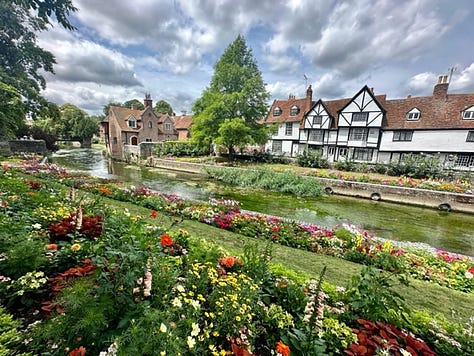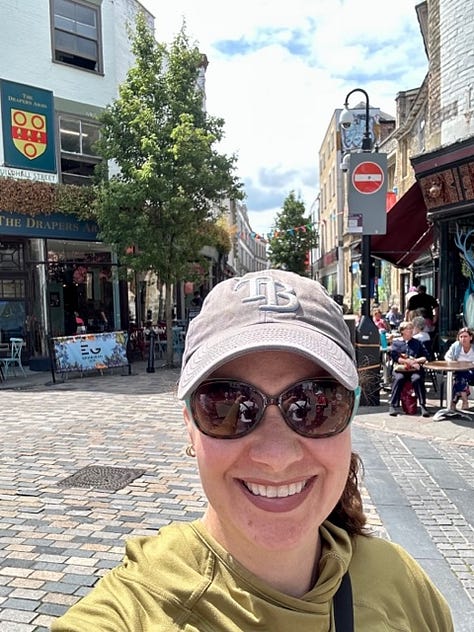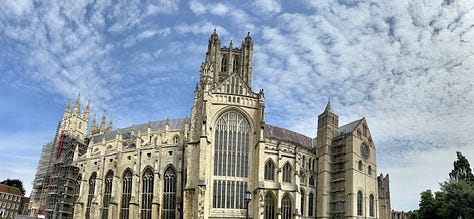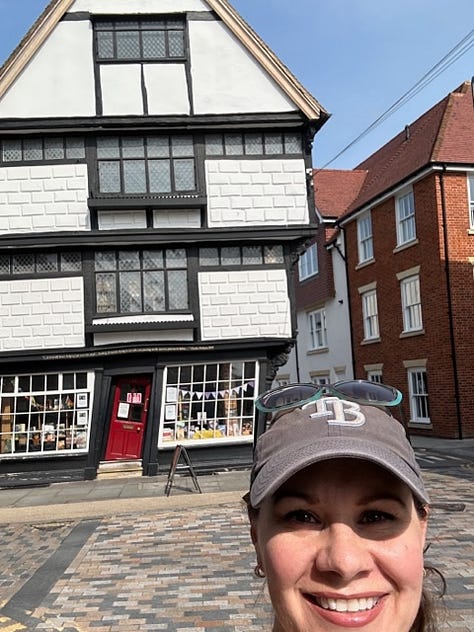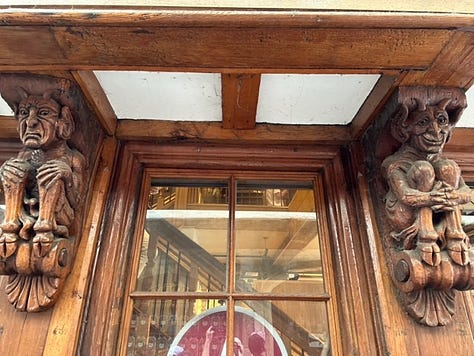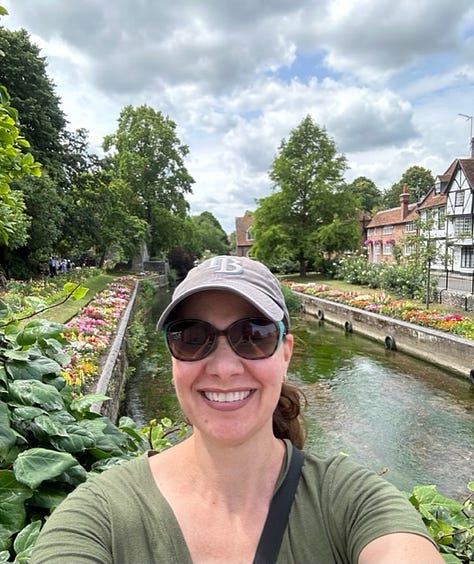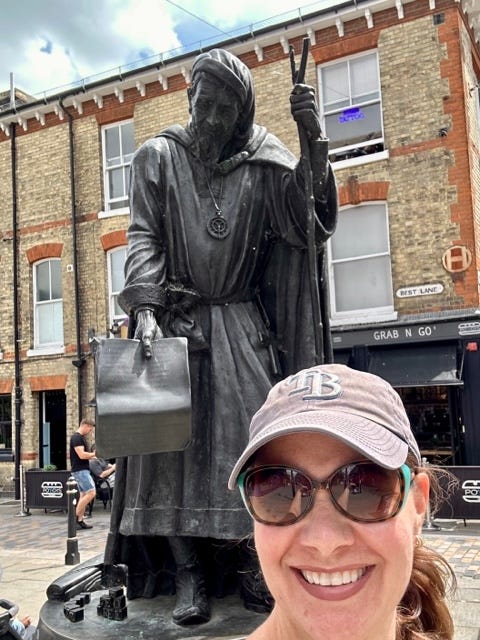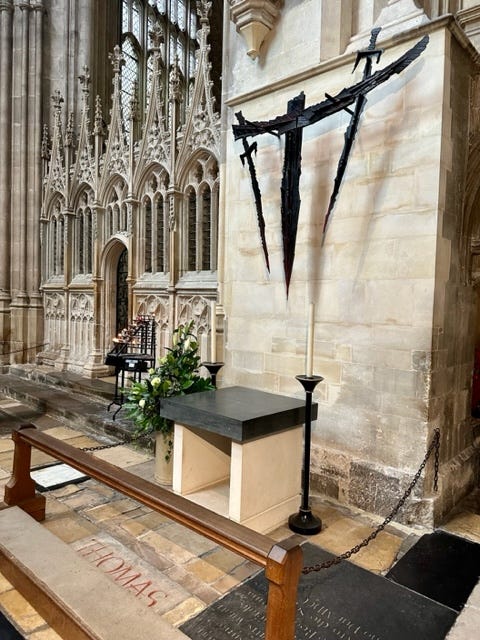A "Troublesome Priest" and the Perils of Literalism
(Or: "I'm Canterbur-ied under my overflowing inbox after a month away" )
As you may or may not have noticed, we didn’t have a June edition of the Lēros Project. I felt guilty for exactly 2.7 seconds, and then I remembered that my monthly publication goal is self-imposed and that this is literally the lowest stakes proposition imaginable. Here’s to cutting ourselves a little slack.
What was I doing for the month of June instead of writing a newsletter just for you, dear reader? Quite simply, I was traipsing about the UK, celebrating my parents’ 50th anniversary, conducting some research, speaking at a church or two, seeing old friends, contracting Covid, and cancelling on other friends as a result. Plague aside, it was an outstanding trip, and I feel so blessed to have been able to see and do so much.
One of my stops toward the end of my gallivant was Canterbury, which has always been on my “to visit” list but somehow always got put on hold when I lived in the UK for dumb reasons like train strikes or being a poor graduate student. This time, however, I was determined to finally go and see it…but after a quarter-century of hype, could it possibly live up to my expectations?
I am pleased to say it far exceeded them.
There are so many things I want to say about Canterbury, from the fact that the medieval town survived the Blitz due to a geographical quirk that results in a steady easterly wind that blew Nazi target flares away from the historical areas to the fact that the city leans hard into its eponymous “Tales” legacy (and doesn’t gloss over the bawdy bits the way your sophomore English teacher did).
But the thing I want to focus on here is the cathedral, because it’s not just a UNESCO World Heritage Site or a superlative example of Gothic, Norman, and Romanesque architecture combined or the Mother Church of the Anglican faith or one of the most beautiful places I have ever seen in my life. Canterbury Cathedral needs to be discussed more because of the testimony it bears to the importance of the separation between church and state.
The cathedral is the site of the martyrdom of (and subsequent shrine to) Thomas Becket, an advisor to King Henry II of England. Henry made Becket Archbishop of Canterbury in 1162 in the hopes of having a puppet in power who would do the bidding of the Crown. Becket was not a perfect man, but did he refuse to be Henry’s doormat. The king grew increasingly frustrated with his old friend until he allegedly blurted out at a Christmas feast in 1170, “Will no one rid me of this troublesome priest?”[1]
Four knights who were present saw this as their opportunity to win the king’s favor, and four days later, on December 29, burst into the church and decapitated Becket while he was conducting a service. According to legend, Becket heard the knights coming for him but refused to bar the door because he believed the church should never be shut to anyone.
When Henry found out, he was devastated that his rash words had led to this murder. The four knights were sent on crusade to atone for their actions, and the king himself traveled to Canterbury Cathedral to keep vigil and pray for forgiveness at Becket’s shrine, as did thousands of religious pilgrims from all over the world from the Middle Ages through to today. (This is the whole reason the travelers are gathered together in the Canterbury Tales, after all.)

There are so many points we can take from this historical event, but after visiting the site and seeing the way in which the church honors all martyrs of governmental persecution and the importance of maintaining a separation of church and state, a few lessons stood out to me as especially significant.
1) People who are willing to stand up to bullying politicians and say, “The church is not an arm of your agenda” generally land on the right side of history.
2) Martyrdom is very much alive and well in our modern world.
3) Teachers not giving preference to one faith tradition in the classroom or people failing to use your preferred yuletide greeting does not a martyrdom make.
4) When we take literally words spoken by people in authority without concern for context, temperament, or rational thought, we can cause immense harm that echoes for centuries.
5) There will always be opportunists who are ready to injure others for the sake of their own glory.
6) Despite what recent history has shown us, people in power are capable of not only admitting when they have made a mistake but of taking personal responsibility for it.
I’ll let you ruminate on those points without elaboration, save to add that we are all familiar with Winston Churchill’s observation that “Those that fail to learn from history are doomed to repeat it.”
And yet…here we are.

I want to share two resources you might find interesting. (Please note that this is not a commercial. Literally no one cares about my opinion enough to pay me for it, and I don’t endorse anything that I have not personally read, studied, experienced, or otherwise engaged with.)
First, Zack Hunt, a Yale Divinity School grad and friend of the late, great Rachel Held Evans, recently published a book called Godbreathed: What it Really means for the Bible to be Divinely Inspired. He was kind enough to send me an advance copy of it (along with a Japanese kintsugi bowl as a reminder that cracks can reveal beauty). This is a challenging and important book that explores the history of biblical literalism (it’s much more recent than you might imagine) and how to respect the teachings of the Bible without making an idol out of ideologies. Click on the link above to check it out. It’s a fascinating read.
Secondly, Dr. Michael Simmons of Portland Seminary is teaching a five-week course on Jungian shadow-work and Christian spiritual formation. I had the privilege of taking a course on shadow-work and healing from Dr. Simmons, and it was exceptional. This course promises to be just as fantastic, and it’s a heck of a lot cheaper than what I paid for it as a required course in seminary. Check out the link and details here: Companioning Our Shadow: Befriending Emotions, Healing Relationships; Wednesdays, August 2nd through 30th (5 weeks); 12pm-2pm EDT, 9am-11am PDT; cost: $200.
